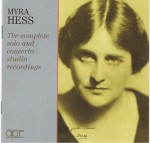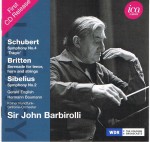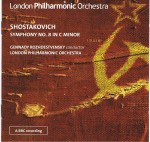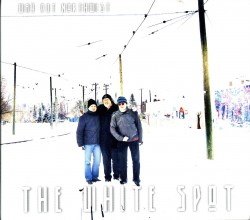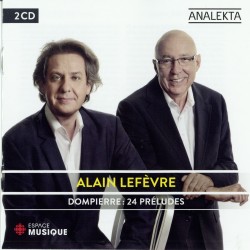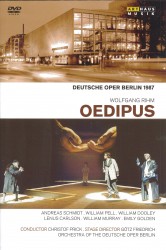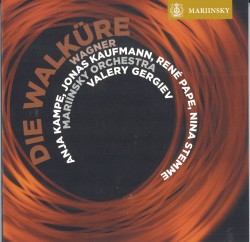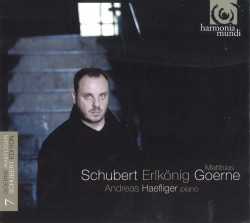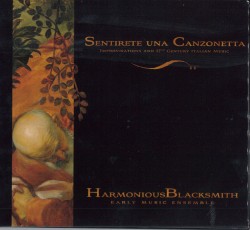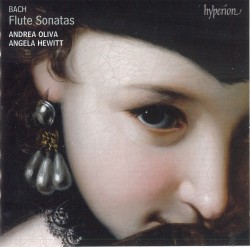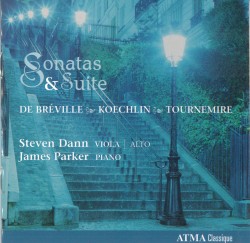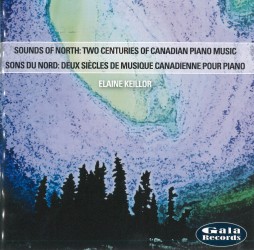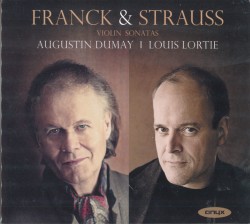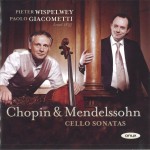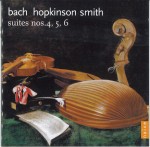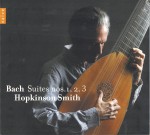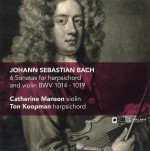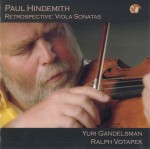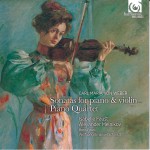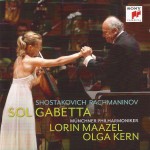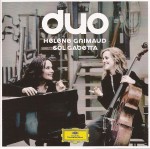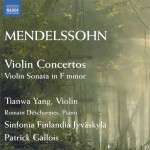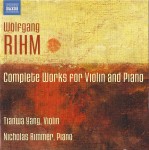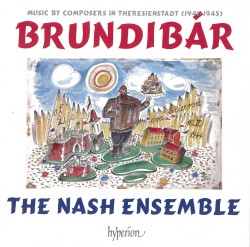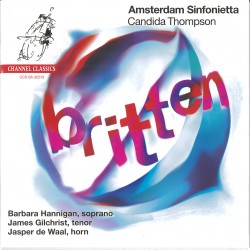Something in the Air - Liberation of the Unaccompanied Bass Solo
Of all the instruments that needed the advances of free music in the 20th century to show off its true character, it has been the double bass which benefitted most from this situation. Relegated to decorative, scene setting or mere rhythmic functions in conventional classical and jazz performances, it was only when bassists were able to express themselves without restraint that their role grew. By the 21st century in fact, solo bass recitals became as commonplace as those by other instrumentalists. The reason, as these CDs demonstrate, is the arrival of performers who can extract a multiplicity of novel tones, timbres and textures from four tautly wound strings.
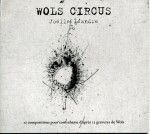 Take Paris-based Joëlle Léandre for instance. Early in her career she played pieces composed specifically for her by the likes of John Cage and Giacinto Scelsi; now she’s fully committed to free expression. Wols circus: 12 compositions pour contrebasse d’après 12 gravures de Wols (Galerie Hus HUS 112 joelle-leandre.com) is particularly fascinating. Using only a bow, the strings, her instrument’s body and her own vocal inflections, Léandre interprets musically engravings by Surrealist artist Otto Wols (1913–1951). Created from 1942–1945, when the Berlin-born Wols was interned as an “enemy foreigner” in France, where he lived from 1932 until his death, the images are as abstract as they are affecting. Making no attempt to literally replicate the drawings in music, Léandre’s sound interpretations move from stentorian to muted, with indistinct, spiccato scrubs as common as Jew’s harp-like twangs. Especially noteworthy is the build-up and release reflected on the successive Topographie, Drei Vingnetten auf einem Blatt and Keiner Fleck. With each sequence three minutes, first abrasive then mellow string sawing fades into occasional arco slides and sul tasto pops with the air vibrated by the bow audible as well. The climax occurs as unison basso string strokes and Léandre’s vocal growls give way to a contrapuntal duet between sharp instrumental lines. Throughout, the bull fiddler provides personalized a view of Wols’ sketches with additional string inventions ranging from squeeze-toy peeps to tremolo bass slaps. Nonetheless the defining performance occurs with Dunkle Stadt, when with intensifying torque she moves from miniscule below-the-bridge plucks to staccato string chirps contrapuntally layered with vocalized faux lyric soprano accents.
Take Paris-based Joëlle Léandre for instance. Early in her career she played pieces composed specifically for her by the likes of John Cage and Giacinto Scelsi; now she’s fully committed to free expression. Wols circus: 12 compositions pour contrebasse d’après 12 gravures de Wols (Galerie Hus HUS 112 joelle-leandre.com) is particularly fascinating. Using only a bow, the strings, her instrument’s body and her own vocal inflections, Léandre interprets musically engravings by Surrealist artist Otto Wols (1913–1951). Created from 1942–1945, when the Berlin-born Wols was interned as an “enemy foreigner” in France, where he lived from 1932 until his death, the images are as abstract as they are affecting. Making no attempt to literally replicate the drawings in music, Léandre’s sound interpretations move from stentorian to muted, with indistinct, spiccato scrubs as common as Jew’s harp-like twangs. Especially noteworthy is the build-up and release reflected on the successive Topographie, Drei Vingnetten auf einem Blatt and Keiner Fleck. With each sequence three minutes, first abrasive then mellow string sawing fades into occasional arco slides and sul tasto pops with the air vibrated by the bow audible as well. The climax occurs as unison basso string strokes and Léandre’s vocal growls give way to a contrapuntal duet between sharp instrumental lines. Throughout, the bull fiddler provides personalized a view of Wols’ sketches with additional string inventions ranging from squeeze-toy peeps to tremolo bass slaps. Nonetheless the defining performance occurs with Dunkle Stadt, when with intensifying torque she moves from miniscule below-the-bridge plucks to staccato string chirps contrapuntally layered with vocalized faux lyric soprano accents.
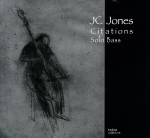 Unlike Léandre, whose 12 acoustic selections were recorded at one live concert, French-Israeli bassist JC Jones’ Citations: Solo Bass (Kadima Collective KCR 36 kadimacollective.com) is made up of 17 untitled compositions and improvisations from 2008 to 2012 using acoustic bass or electro-acoustic bass with live electronics. To be honest the computer processes aren’t that prominent; but are mostly used to provide a constant pizzicato undercurrent, while Jones’ arco buzzes add multiphonic sweeps or balladic decorations to the selections. More individual are the improvisations, which sometimes had been created to accompany dancers. On the 11th track for instance, rosin seems to be sliding off the bass strings as Jones slaps them agitato and tremolo so that soundboard thumps resonate throughout the instrument’s body. Buzzing spiccato action with banjo-like plucks from below the bridge succeed spanked string rhythms on the 15th track; while on the fifth Jones manages to sound as if he’s manipulating two basses at once without overdubbing. Here he plucks and shakes the strings in the instrument’s top range while ruggedly double- and triple-stopping from the bottom, resulting in snaps, knocks and pops ricocheting back onto one another. Moreover a track such as 17 sums up all the preceding strategies as Jones manages to isolate three separate theme variations. Not only are stentorian thumps and undulating bow motions heard, but so too is a third tremolo impulse harmonized alongside the first two.
Unlike Léandre, whose 12 acoustic selections were recorded at one live concert, French-Israeli bassist JC Jones’ Citations: Solo Bass (Kadima Collective KCR 36 kadimacollective.com) is made up of 17 untitled compositions and improvisations from 2008 to 2012 using acoustic bass or electro-acoustic bass with live electronics. To be honest the computer processes aren’t that prominent; but are mostly used to provide a constant pizzicato undercurrent, while Jones’ arco buzzes add multiphonic sweeps or balladic decorations to the selections. More individual are the improvisations, which sometimes had been created to accompany dancers. On the 11th track for instance, rosin seems to be sliding off the bass strings as Jones slaps them agitato and tremolo so that soundboard thumps resonate throughout the instrument’s body. Buzzing spiccato action with banjo-like plucks from below the bridge succeed spanked string rhythms on the 15th track; while on the fifth Jones manages to sound as if he’s manipulating two basses at once without overdubbing. Here he plucks and shakes the strings in the instrument’s top range while ruggedly double- and triple-stopping from the bottom, resulting in snaps, knocks and pops ricocheting back onto one another. Moreover a track such as 17 sums up all the preceding strategies as Jones manages to isolate three separate theme variations. Not only are stentorian thumps and undulating bow motions heard, but so too is a third tremolo impulse harmonized alongside the first two.
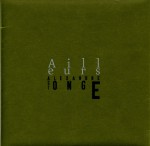 If Jones’ electronic interface is limited, Montreal-based Alexandre St-Onge and Norwegian-in-Austin Ingebrigt Håker Flaten draw more textures to their finger tips by utilizing amplified electric basses on their solos sessions. A member of bands such as Klaxon Gueule, as well as studying for his PhD in art, St-Onge describes himself as a sound performer and the six selections on Ailleurs (&records ET18 etrecords.net) are studded as much with signal-processed drones and splutters as reflective string modulations. Layering the sequences with loops that replicate sounds ranging from ring-modulator whooshes to bell ringing and distorted flanges, the basic double bass-like rhythmic qualities of the instrument are muted. Only on the fifth track does the tremolo, dial-twisting exposition pull back enough for a semi-acoustic interlude. Here juddering bass-string plucks can be heard contrapuntally advancing the narrative, which is still decorated with additional droning lines and wiggling voltage-affiliated cries. The achievement of Ailleurs is that by mutating its intonation and freeing the bass from its limitations as a purely rhythmic instrument a new interface appears. The reverberating result is of an expansive formula that evocatively builds on expected bull fiddle timbres the way a realistic photograph could be the basis for a surrealistic art
If Jones’ electronic interface is limited, Montreal-based Alexandre St-Onge and Norwegian-in-Austin Ingebrigt Håker Flaten draw more textures to their finger tips by utilizing amplified electric basses on their solos sessions. A member of bands such as Klaxon Gueule, as well as studying for his PhD in art, St-Onge describes himself as a sound performer and the six selections on Ailleurs (&records ET18 etrecords.net) are studded as much with signal-processed drones and splutters as reflective string modulations. Layering the sequences with loops that replicate sounds ranging from ring-modulator whooshes to bell ringing and distorted flanges, the basic double bass-like rhythmic qualities of the instrument are muted. Only on the fifth track does the tremolo, dial-twisting exposition pull back enough for a semi-acoustic interlude. Here juddering bass-string plucks can be heard contrapuntally advancing the narrative, which is still decorated with additional droning lines and wiggling voltage-affiliated cries. The achievement of Ailleurs is that by mutating its intonation and freeing the bass from its limitations as a purely rhythmic instrument a new interface appears. The reverberating result is of an expansive formula that evocatively builds on expected bull fiddle timbres the way a realistic photograph could be the basis for a surrealistic art
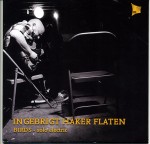 As abstract in execution as St-Onge and as familiar with as many electronic extensions, on the six tracks which make up Birds – Solo Electric (Tektite Records ingebrigtflaten.com), Ingebrigt Håker Flaten at least follows the convention of titling his tracks. Known for his membership in bands such as The Thing and Atomic, he’s able to play the electric bass in such a way to suggest multiple instruments. The most breathtaking instance of this occurs on Chicago. Pulsating the top string of his highly amplified bass with spiccato pressure, Flaten produces timbres that could as easily have come from a bagpipe chanter or a piccolo trumpet. At the same time modulated feedback decorates the exposition, while a legato theme is heard from the top guitar-like strings. Eventually this broken-octave display fades into measured stops. Mercurial and rubato, many of the other tones in his improvisations sound as if they are extended by an e-bow. Take a track like Lucia. Here string slaps alternate with flanges that could come from backward running tapes, until a vigourous melody surmounts those sounds. Whistles, whooshes, crackles and other amplified flutters predominate throughout, but when Flaten strikes or scrapes the strings with firecracker-like resonation, he confirms the true instrumental origin of the performances.
As abstract in execution as St-Onge and as familiar with as many electronic extensions, on the six tracks which make up Birds – Solo Electric (Tektite Records ingebrigtflaten.com), Ingebrigt Håker Flaten at least follows the convention of titling his tracks. Known for his membership in bands such as The Thing and Atomic, he’s able to play the electric bass in such a way to suggest multiple instruments. The most breathtaking instance of this occurs on Chicago. Pulsating the top string of his highly amplified bass with spiccato pressure, Flaten produces timbres that could as easily have come from a bagpipe chanter or a piccolo trumpet. At the same time modulated feedback decorates the exposition, while a legato theme is heard from the top guitar-like strings. Eventually this broken-octave display fades into measured stops. Mercurial and rubato, many of the other tones in his improvisations sound as if they are extended by an e-bow. Take a track like Lucia. Here string slaps alternate with flanges that could come from backward running tapes, until a vigourous melody surmounts those sounds. Whistles, whooshes, crackles and other amplified flutters predominate throughout, but when Flaten strikes or scrapes the strings with firecracker-like resonation, he confirms the true instrumental origin of the performances.
With the creativity on display on any one of these CDs so obvious, hearing the bass used merely for decorative or rhythmic functions in the future will likely be disappointing for many.



